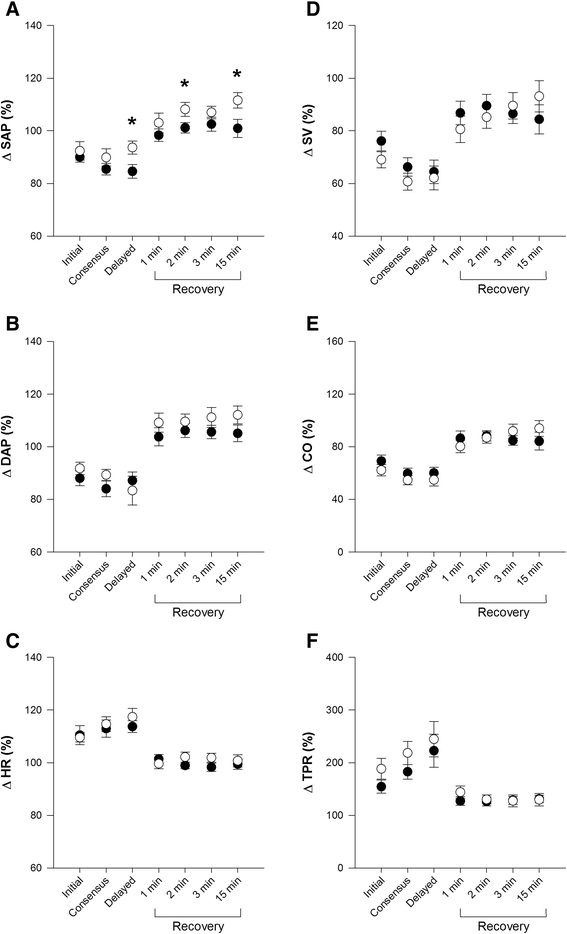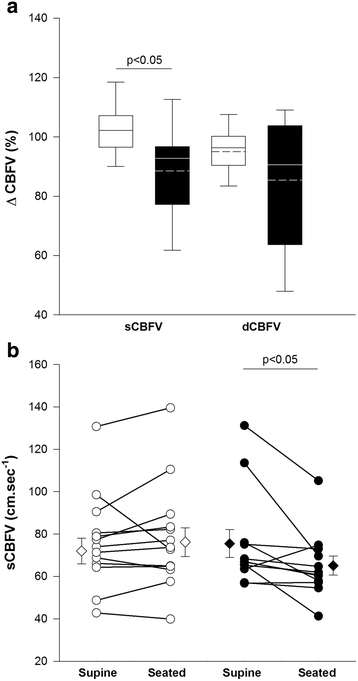Cardiovascular responses to orthostasis and their association with falls in older adults
- PMID: 26703012
- PMCID: PMC4690276
- DOI: 10.1186/s12877-015-0168-z
Cardiovascular responses to orthostasis and their association with falls in older adults
Abstract
Background: Orthostatic hypotension (OH) refers to a marked decline in blood pressure when upright. OH has a high incidence and prevalence in older adults and represents a potential intrinsic risk factor for falls in these individuals. Previous studies have not included more recent definitions for blood pressure responses to orthostasis, including initial, delayed, and recovery blood pressure responses. Furthermore, there is little research examining the relationships between cerebrovascular functioning and falling risk. Therefore, we aimed to: (i) test the association between different blood pressure responses to orthostatic stress and retrospective falling history and; (ii) test the association between cerebrovascular responses to orthostatic stress and falling history.
Methods: We tested 59 elderly residents in long term care facilities who underwent a passive seated orthostatic stress test. Beat-to-beat blood pressure and cerebral blood flow velocity (CBFV) responses were assessed throughout testing. Risk factors for falls and falling history were collected from facility records. Cardiovascular responses to orthostasis were compared between retrospective fallers (≥1 fall in the previous year) and non-fallers.
Results: Retrospective fallers had larger delayed declines in systolic arterial pressure (SAP) compared to non-fallers (p = 0.015). Fallers also showed poorer early (2 min) and late (15 min) recovery of SAP. Fallers had a greater decline in systolic CBFV.
Conclusions: Older adults with a positive falling history have impaired orthostatic control of blood pressure and CBFV. With better identification and understanding of orthostatic blood pressure impairments earlier intervention and management can be implemented, potentially reducing the associated risk of morbidity and mortality. Future studies should utilize the updated OH definitions using beat-to-beat technology, rather than conventional methods that may offer less accurate detection.
Figures


Similar articles
-
Relationships between orthostatic hypotension, frailty, falling and mortality in elderly care home residents.BMC Geriatr. 2019 Mar 13;19(1):80. doi: 10.1186/s12877-019-1082-6. BMC Geriatr. 2019. PMID: 30866845 Free PMC article.
-
The degree and timing of orthostatic blood pressure changes in relation to falls in nursing home residents.J Am Med Dir Assoc. 2004 Jul-Aug;5(4):233-8. doi: 10.1097/01.JAM.0000129837.51514.93. J Am Med Dir Assoc. 2004. PMID: 15228632
-
The relationship between orthostatic hypotension and falling in older adults.Clin Auton Res. 2014 Feb;24(1):3-13. doi: 10.1007/s10286-013-0219-5. Epub 2013 Nov 20. Clin Auton Res. 2014. PMID: 24253897 Review.
-
Postural blood pressure electrocardiographic changes are associated with falls in older people.Clin Auton Res. 2016 Feb;26(1):41-8. doi: 10.1007/s10286-015-0327-5. Epub 2015 Dec 22. Clin Auton Res. 2016. PMID: 26695401
-
Noninvasive beat-to-beat finger arterial pressure monitoring during orthostasis: a comprehensive review of normal and abnormal responses at different ages.J Intern Med. 2017 Dec;282(6):468-483. doi: 10.1111/joim.12636. Epub 2017 Jul 10. J Intern Med. 2017. PMID: 28564488 Review.
Cited by
-
The relative importance of frailty, physical and cardiovascular function as exercise-modifiable predictors of falls in haemodialysis patients: a prospective cohort study.BMC Nephrol. 2020 Mar 14;21(1):99. doi: 10.1186/s12882-020-01759-z. BMC Nephrol. 2020. PMID: 32169050 Free PMC article.
-
Cardiovascular Disorders and Falls Among Older Adults: A Systematic Review and Meta-Analysis.J Gerontol A Biol Sci Med Sci. 2024 Feb 1;79(2):glad221. doi: 10.1093/gerona/glad221. J Gerontol A Biol Sci Med Sci. 2024. PMID: 37738307 Free PMC article.
-
Validation of Evidence-Based Fall Prevention Programs for Adults with Intellectual and/or Developmental Disorders: A Modified Otago Exercise Program.Front Public Health. 2016 Dec 6;4:261. doi: 10.3389/fpubh.2016.00261. eCollection 2016. Front Public Health. 2016. PMID: 27999771 Free PMC article.
-
Baroreflex function, haemodynamic responses to an orthostatic challenge, and falls in haemodialysis patients.PLoS One. 2018 Dec 6;13(12):e0208127. doi: 10.1371/journal.pone.0208127. eCollection 2018. PLoS One. 2018. PMID: 30521545 Free PMC article.
-
Cardiovascular Autonomic Dysfunction and Falls in People With Multiple Sclerosis: Is There a Link? An Opinion Article.Front Neurosci. 2020 Dec 7;14:610917. doi: 10.3389/fnins.2020.610917. eCollection 2020. Front Neurosci. 2020. PMID: 33364920 Free PMC article. No abstract available.
References
-
- World Health Organization . In: WHO global report on falls prevention in older age. Salas-Rojas C, editor. Geneva: World Health Organization; 2007. p. 53.
-
- Scott V, Wager L, Elliot S. In: Falls & related injuries among older Canadians: fall-related hospitalizations & prevention initiatives. Public Health Agency of Canada DoAaS, editor. Victoria: Victoria Scott Consulting; 2010. p. 186.
Publication types
MeSH terms
Grants and funding
LinkOut - more resources
Full Text Sources
Other Literature Sources
Medical
Miscellaneous

